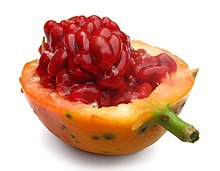Passiflora caerulea
| Passiflora caerulea | |
|---|---|

| |
| Flower in full bloom together with a wilted flower and a yet unopened bud | |

| |
| Fruit cut and opened | |
| Scientific classification | |
| Kingdom: | Plantae |
| Clade: | Tracheophytes |
| Clade: | Angiosperms |
| Clade: | Eudicots |
| Clade: | Rosids |
| Order: | Malpighiales |
| Family: | Passifloraceae |
| Genus: | Passiflora |
| Species: | P. caerulea
|
| Binomial name | |
| Passiflora caerulea | |
Passiflora caerulea, the blue passionflower,[1] bluecrown passionflower[2] or common passion flower, is a species of flowering plant native to South America. It has been introduced elsewhere. It is a vigorous, deciduous or semi-evergreen tendril vine growing to 10 m (33 ft) or more. Its leaves are palmate and fragrant, flowers blue-white with a prominent fringe of coronal filaments in bands of blue, white, and brown. The ovoid orange fruit, growing to 6 cm (2 in), is edible but bland.[3]
Names[]
This popular and showy plant has attracted a number of common names. In Paraguay it is widely known as mburucuyá in Guaraní. Other names include the blue crown, flower of five wounds, southern beauty, wild apricot, Jesus flower. The specific epithet caerulea means "blue" and refers to the blue coronal filaments.[4] In Japan it is called 時計草 (Clock plant) due to having 12 petals, a central stamen and stigmas resembling a timepieces's winding mechanism, and curly green tendrils resembling wound springs. In India this is known as “Krishna Kamal”.
Description[]

Passiflora caerulea is a woody vine capable of growing to 25 metres (82 ft) high where supporting trees are available.[5] The leaves are alternate, palmately five-lobed (sometimes three, seven, or nine lobes), and are up to 10 centimetres (3.9 in) in length while being linear-oblong shaped.[6] The base of each leaf has a flagellate-twining tendril 5–10 centimetres (2.0–3.9 in) long, which twines around supporting vegetation to hold the plant up.[5]
The flower is complex, about 10 centimetres (3.9 in) in diameter,[6] with the five sepals and petals similar in appearance, whitish in colour, surmounted by a corona of blue or violet filaments, then five greenish-yellow stamens and three purple stigmas.[5] The fruit is an oval orange-yellow berry, 6 centimetres (2.4 in) long by 4 centimetres (1.6 in) in diameter, containing numerous seeds.[5] It is edible to humans when ripe, but tends to have an undesirable flavour.[7]
Cultivation[]
Passiflora caerulea is widely cultivated as a wall-climber or as groundcover. Though hardy down to −10 °C (14 °F), it requires a sheltered position facing south or west (in the Northern Hemisphere). It can become invasive, the twining shoots constantly appearing unless eradicated. It has gained the Royal Horticultural Society's Award of Garden Merit.[8]
Cultivars[]

A number of cultivars have been produced from the species:-
- 'Chinensis' (corona filaments paler blue)
- 'Constance Elliott' was raised by Kucombe and Prince in Exeter, Great Britain. It has pure white, fragrant flowers; not as free-flowering as many other clones. It has also won the Award of Garden Merit[9]
- 'Pierre Pomie', a pale pink flower form
Chemical constituents[]
Compared to Passiflora incarnata, this plant contains higher amounts of the MAO-inhibitor harmine.[10]
Other uses[]

Though the fruit is edible, it is rather insipid when eaten raw. A tea can be made of the flower or leaves; however, tetraphyllin B and epi-tetraphyllin B, cyanogenic glycosides which liberate hydrogen cyanide when activated by enzymes, have been found in the leaves. It is possible to boil away most of the cyanide.[11]
The passion flower is the national flower of Paraguay. Its intricate structure has generated Christian symbolism, each part representing a different part of the Passion of Christ. The "Etymology and names" section of Passiflora contains more information about this symbolism.
Gallery[]
Flower

Fruit

Flower of Passiflora caerulea

'Constance Elliot', a white flower form

'Pierre Pomie', a pale pink flower form

Peculiarity: two fused filaments force anthers upwards, displaying pollen beds otherwise not visible from this perspective.

A photograph of P. Caerulea
References[]
- ^ BSBI List 2007 (xls). Botanical Society of Britain and Ireland. Archived from the original (xls) on 2015-06-26. Retrieved 2014-10-17.
- ^ "Passiflora caerulea". Natural Resources Conservation Service PLANTS Database. USDA. Retrieved 31 January 2016.
- ^ RHS A-Z encyclopedia of garden plants. United c ZKingdom: Dorling Kindersley. 2008. p. 1136. ISBN 978-1405332 965.
- ^ Harrison, Lorraine (2012). RHS Latin for gardeners. United Kingdom: Mitchell Beazley. p. 224. ISBN 9781845337315.
- ^ a b c d "Factsheet - Passiflora caerulea (Blue Passionflower)". keys.lucidcentral.org. Retrieved 14 August 2018.
- ^ a b "Passiflora caerulea: info from PIER (PIER species info)". www.hear.org. Pacific Island Ecosystems at Risk project (PIER). Retrieved 14 August 2018.
- ^ Popay, Ian. "Passiflora caerulea (blue passionflower)". www.cabi.org. Retrieved 14 August 2018.
- ^ "RHS Plant Selector - Passiflora caerulea". Archived from the original on 7 August 2013. Retrieved 25 May 2013.
- ^ "RHS Plantfinder - Passiflora caerulea 'Constance Elliott'". Retrieved 18 April 2018.
- ^ Frye, Abigail; Haustein, Catherine (2007). "Extraction, Identification, and Quantification of Harmala Alkaloids in Three Species of Passiflora". American Journal of Undergraduate Research. 6 (3). doi:10.33697/ajur.2007.020.
- ^ DS Seiglera, KC Spencera, WS Statlerb, EE Connb, JE Dunnb, 'Tetraphyllin B and epitetraphyillin B sulphates: Novel cyanogenic glucosides from Passiflora caerulea and P. alato-caerulea', Phytochemistry, 21/9 (1982), 2277-2285.
External links[]
| Wikimedia Commons has media related to Passiflora caerulea. |
- Passiflora
- Flora of Argentina
- Flora of Brazil
- Flora of Uruguay
- Garden plants of South America
- Plants described in 1753
- Taxa named by Carl Linnaeus






